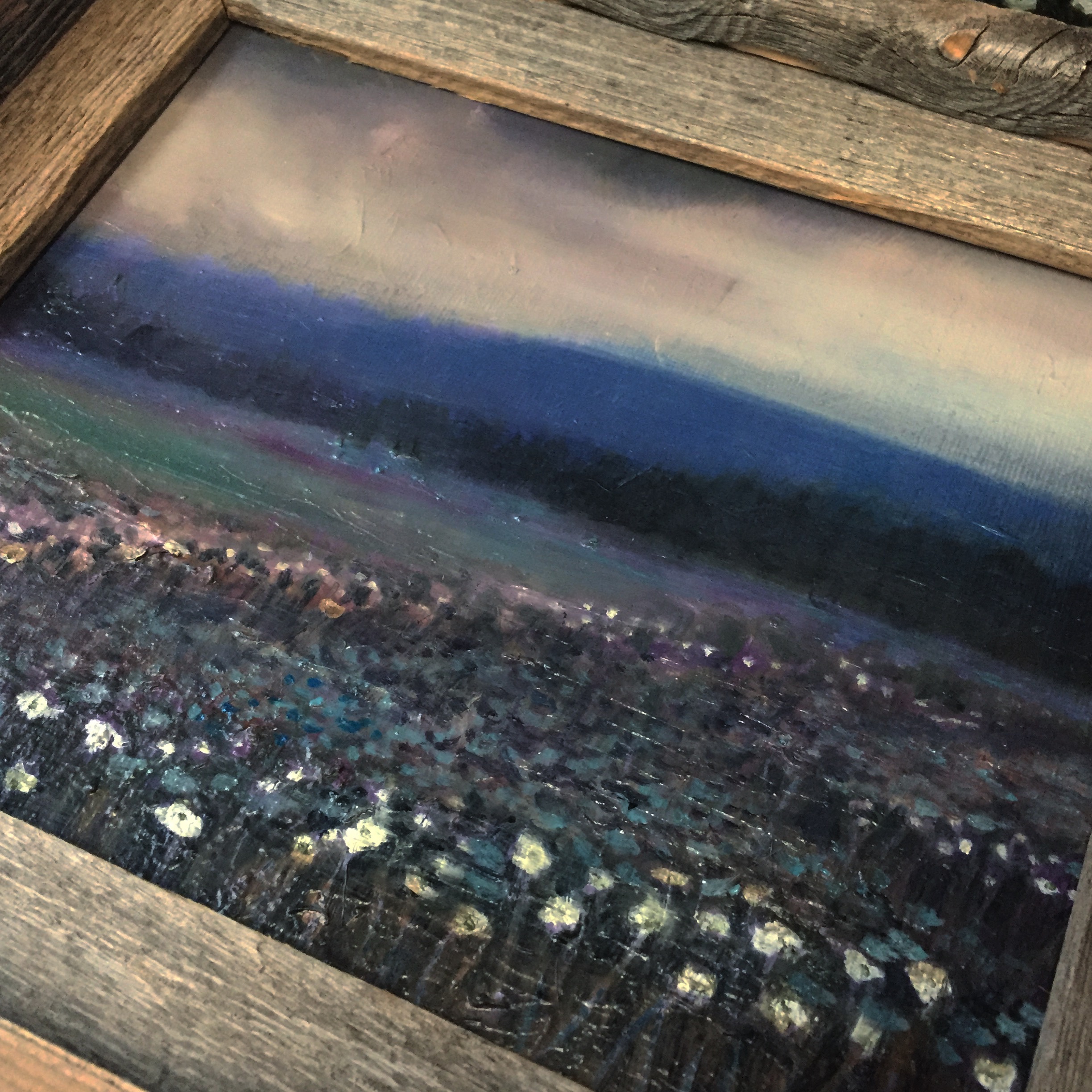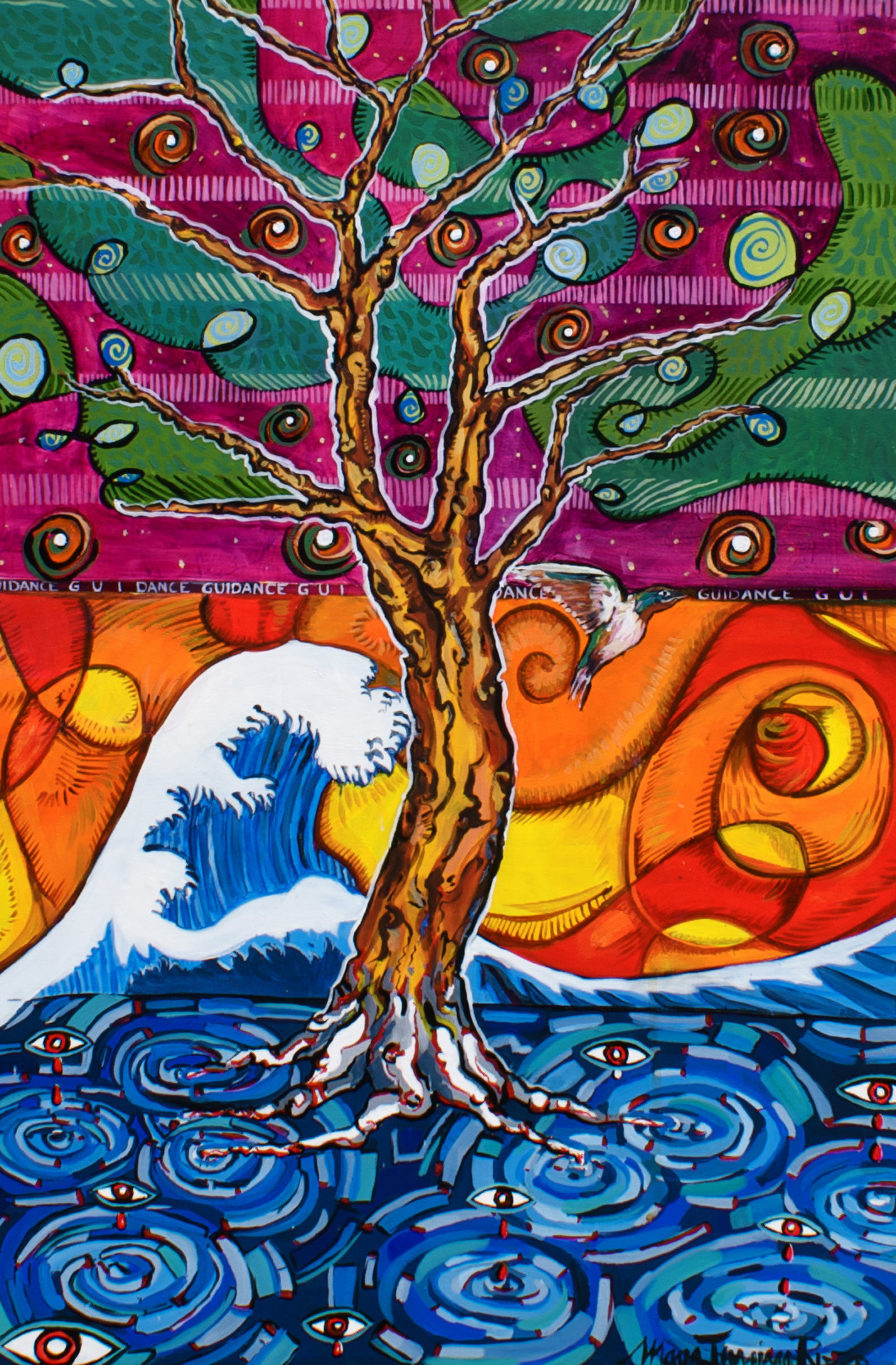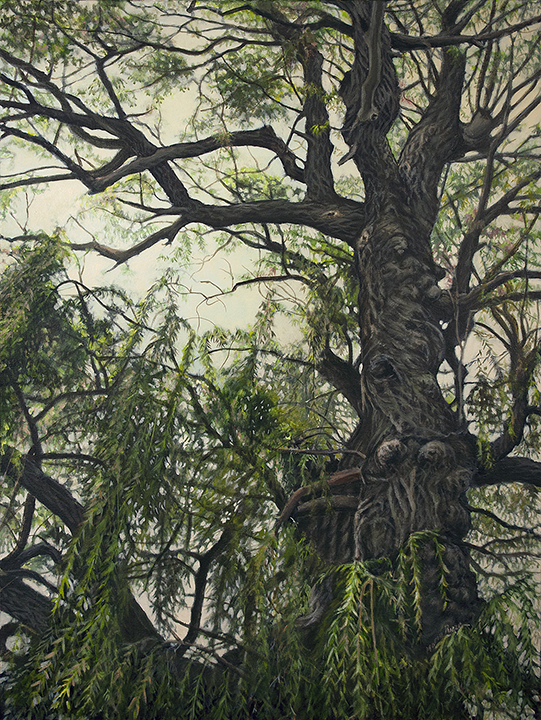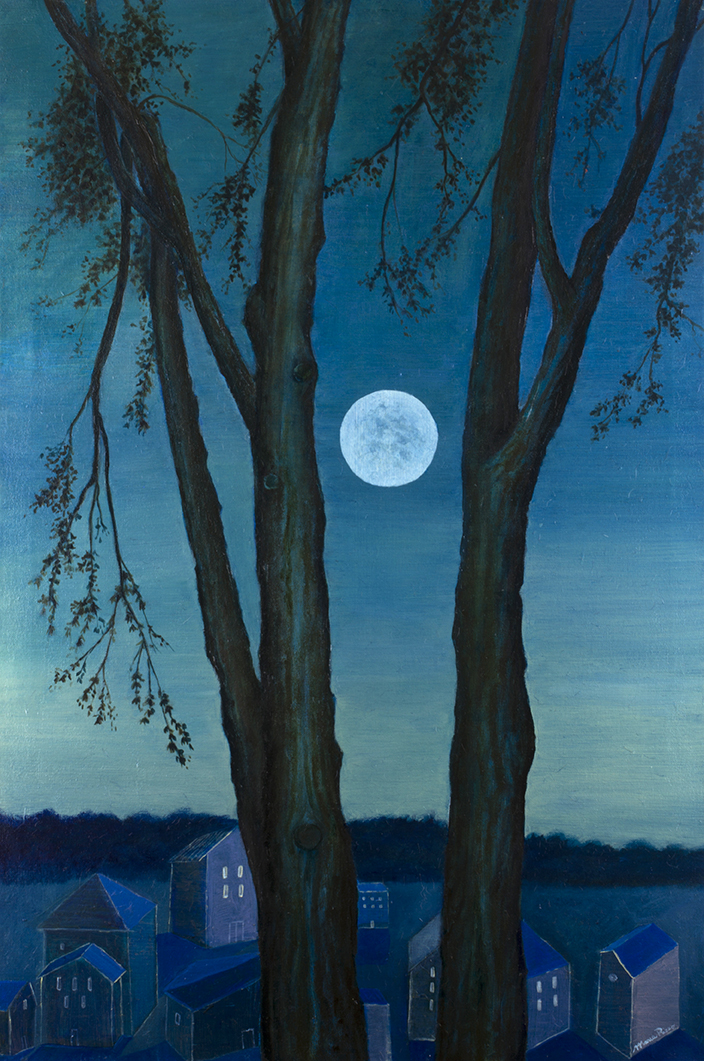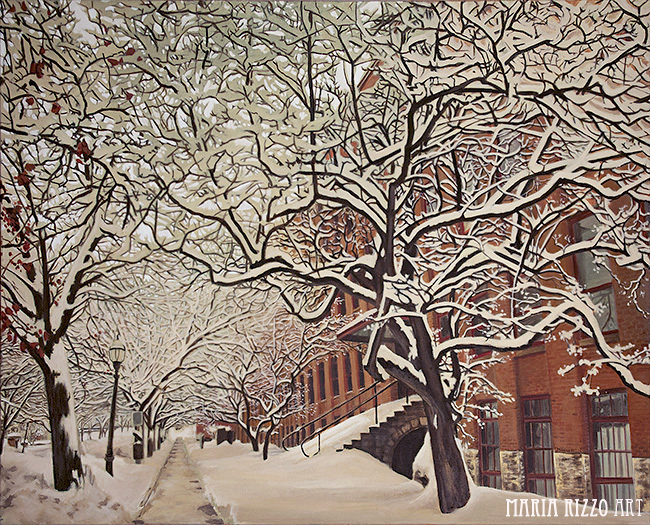Tips on How to Write an Effective Artist Statement
What I've realized, looking back to my 7 years running my creative business, is that my artist statement has been one of the most essential marketing tools I used to land opportunities to show my art, to win grants and awards, and to be published in articles and books. Click the link to learn how you can write a more effective artist statement.
If you are like me, you might have questioned why fine artists need an artist statement to show their art and, furthermore, you might wonder how do artists write an artist statement without sounding boring or uptight.
The Language of Trees at the Redhouse Art Center in Syracuse, NY, 2013. Curated by Marianne Dalton.
Yet, what I've realized, looking back to my 7 years running my creative business, is that my artist statement has been one of the most essential marketing tools I used to land opportunities to show my art, to win grants and awards, and to be published in articles and books.
Caroll Michell, the author of How to Survive and Prosper as an Artist, on the subject of the artist statement, writes:
An artist statement can be used as a tool to help dealers, art consultants, and advisors to sell your work, and as background information in helping writers, critics, and curators prepare articles, reviews, and exhibition catalogs. In addition, an artist statement can be incorporated into a cover letter..., on your Web site..., and into grant applications. (53)
Yet, Michell doesn't stop there as she gives some sound advice. The author writes:
An artist statement can focus on one or more topic, such as symbols and metaphors, materials and techniques, or themes or issues underlying or influencing your work. (53)
Maria Rizzo in front of the Onondaga Symbolic Tree, a community painting funded by the 2014 Individual Artist Grant from CNY Arts. Photo credits: Ray Trudell.
Another great piece of advice comes from Constance Smith, the author of Art Marketing 101. Smith asserts:
A correctly developed artist statement takes the reader to the heart of why you are an artist. It is a written dissertation of the idea behind your artwork, your personal philosophy -- the aim of your work. (139)
Here are some facts about the artist statement which I drew from Art Marketing 101:
It changes over time.
It's not the artist's life story.
It explains in words what the artist created in his or her art.
It is used by journalists, curators, art advisors, and art dealers to better understand the artist's work and to communicate his or her art philosophy to others.
It's used by the artist into as a copy for all his or her promotional materials.
It shouldn't be too long, a paragraph works.
It should be clear and simple.
- It should reflect your personality with the use of words that are meaningful to you.
Moody Trees II, oil on canvas by Maria Rizzo. Private Collector.
My artist statement has changed many times throughout the years. I have an upcoming senior exhibition scheduled for Tuesday, April 4, 2017 at SUNY Empire State College where I will showcase art I've created from 2012 to present so, I had to rewrite a new artist statement to better reflect my creative drive throughout the years. For marketing convenience, I also decided to write a longer artist statement for the art exhibition and a shorter one to use on all my promotional materials.
ARTIST STATEMENT
These paintings are trees and nature scenes created as a response to those places which deeply resonate with me. Although several paintings are copies from life; I adore creating art based from the real world but vividly transformed by my infatuation for soothing colors like purples, greens, and blues. I truly enjoy creating paintings that reflect my admiration for nature's creative force. With each brushstroke, I feel a connection with its whimsical energy.
My approach to painting depends on the complexity of the subject. For example, when I create paintings based from life, I make a pencil sketch first, which I transfer on canvas. Next, I use a monochromatic pittura del fondo to establish the chiaro scuro: the light and dark values of the composition. Once the underpainting is finished, I add the velatura, glazes of color, that add to the realism of the painting. When I paint evocative nature scenes, I play with blue-brown washes and bold, bright marks which slowly morph into a suggestive landscape. This creative process begins with a dynamic abstraction and ends into a believable, yet personal, reality.
Like sailing, my creativity is fueled by dedication and perseverance; yet, it is curiosity that allows me to explore its vastness, and grow as an artist.
SHORT ARTIST STATEMENT
My paintings are peculiar trees and evocative nature scenes created as a response to those places which beauty deeply resonated with me. Although several paintings are copies from life; I adore creating art which might be based from the real world but then is vividly transformed by my infatuation for evocative, yet soothing, colors like purples, greens, and blues. I truly enjoy creating paintings that reflect my admiration for nature's creative force as, with each brushstroke, I feel a connection with its whimsical energy. Throughout my creative journey, my drive to paint comes from a desire to express the devotion I feel for nature and my relationship to it.
I hope this blog post will inspire you to write or update your artist statement!
Until next time,
Maria R.
10 Tips to Grow as a Visual Artist
When I was 22 years old, I decided to start a part-time business as a professional painter and my goal for that year was to create a painting’s series because I was told by an established artist, and by many art marketing books, it was the way to be represented by an art gallery. So, I did. I spent the whole year of 2010 creating my first body of work and that was the beginning of my creative venture. But how exactly do you grow as a visual artist? Here are 10 tips that have contributed to my growth as a two-dimensional visual artist.
Detail of Pink Flowers by Maria Rizzo
When I was 22 years old, I decided to start a part-time business as a professional painter and my goal for that year was to create a painting’s series as I was told by an established artist, and by many art marketing books, it was the way to be represented by an art gallery.
So, I did. I spent the whole year of 2010 creating my first body of work and that was the beginning of my creative venture.
Did I land into a commercial art gallery?
Not really.
What I wasn’t told then is that when you start out as an artist, your art is not that good; yet, it is CRUCIAL for you to start somewhere!
My 7 years’ younger self did the best she could do and, if I did let personal fears and other people’s negative opinions stop me then, I could not create the way I do today.
But how exactly do you grow as a visual artist?
Here are 10 tips that have contributed to my growth as a two-dimensional visual artist.
Study of Pears by Maria Rizzo
1) Just create. Don’t let perfectionism and fear stop you from even beginning your creative journey. Be kind to yourself as practice makes the master!
2) Learn the foundations. For any art discipline, to become good at it, you first need to learn the basics. Picasso once said “Learn the rules like a pro, so you can break them like an artist.” For visual artists learning to draw, color theory, and color mixing are crucial for their own long-term artistic success.
3) Learn to attentively observe. Keeping an art journal and sketching what catches your attention is a great way to further develop your eye/hand coordination and technique. A lot of famous artists, along with their sketches, wrote down notes about the colors and other details they observed while drawing their subject matter. This habit allowed these artists to recreate a more developed painting back in their studio, without missing out the important details they experienced while sketching from life. There is nothing wrong in taking a photo as a reference; yet, the point is not to just copy a photo but to put your feelings and experience into your final piece!
Painting tools with a flower field study in oil by Maria Rizzo.
4) Master your tools. In my experience, learning all I could about my art materials and tools was crucial for creating faster. Observing how other professional artists work is truly educational and illuminating. There are many art video tutorials that you can check for free online or think about investing into a local art class by an artist whose work you admire.
5) Go to art museums. My favorite teacher-artist became an exceptional painter by reproducing the art painted by the masters. Thus, reproducing other famous artists’ artwork is a great way to learn about composition, use of color and technique.
6) Stick with one medium. Chose a medium of your liking and master it. Once you are great at it, invest your time into another medium and master that one, as well. Don’t stop there, take the time to use new materials so that in the future you can experiment and find your voice.
Detail of Moody Trees III, oil on canvas by Maria Rizzo, 2017.
7) Take art classes. I’ve spent 5 years mastering acrylic painting until I decided to overcome my fear of oil painting by taking a class with an amazing local artist who paints like the old masters. Learning the basics and steps to create a successful painting from him gave me the confidence necessary to further grow as an artist.
8) Show your art and listen to people’s response. Since 2010, I have shown my art at local art guilds, online art groups, alternative spaces, non-profit galleries, art centers, and museums. Even though it’s always nice to hear positive feedback, what truly made me grow as an artist was receiving constructive criticism which ignited a personal desire to improve my technique, my composition and overall approach to painting.
Flower-field at Night, 8x10' oil on canvas by Maria Rizzo, 2017.
9) Listen to criticism with a grain of salt. Not all criticism is good. In the world, there are always rude people who love to share their misery with the rest of us. These people are not worth your time or energy; thus, do not listen to them, be the bigger person and move on.
10) Don’t compare yourself to other artists. There is nothing more depressing than comparing your art with the artwork made by others. What I’ve learned so far is that it’s way more constructive and realistic to compare my art to the art I created years ago.
Wow!
It’s amazing to visually see the growth I made as an artist through many years of hard work, curiosity, and perseverance. Furthermore, I look forward to see where this creative path will bring me 10 years from now, and yours!
Maria R.
Art Events in Central New York
A lot of people residing in Onondaga County think that there is nothing going on or nothing to do here. Yet, if they knew more about CNY Arts, whose mission “is to promote, support, and celebrate arts and culture in Central New York,” they would start believing otherwise. When you visit cnyarts.org, you will be surprised of all the art and entertainment events you can experience in Central New York.
A lot of people residing in Onondaga County think that there is nothing going on or nothing to do here. Yet, if they knew more about CNY Arts, whose mission “is to promote, support, and celebrate arts and culture in Central New York,” they would start believing otherwise. When you visit cnyarts.org, you will be surprised of all the art and entertainment events you can experience in Central New York.
Furthermore, art and cultural organizations, as well as artists, can create a free account which will allow them to share their events, classes and workshops in the CNY Arts Directory. To get listed, register here: http://weare.cnyarts.org/
About CNY Arts
Who We Are
At CNY Arts, we believe that a healthy arts industry is essential to the quality of life and community in Central New York. We strive to connect the general public to the rich array of arts and cultural opportunities in the area. It doesn’t matter where your place is in the arts—artist, audience member, participant, venue, educator or supporter—we want you to create and experience the arts throughout CNY, in every town, city, neighborhood and school.
What We Do
We provide support and assistance to individual artists and arts and cultural organizations through access to grants, capacity-building assistance, education and training, and promotional services. We serve the counties of Cortland, Herkimer, Madison, Oneida, Onondaga and Oswego. Our goal is to enhance a greater appreciation for the arts and cultural vibrancy of the region. (cnyarts)
Thanks to the CNY Arts Individual Artist Commission Grant, I was able to fund a creative and interactive art project in 2014 that concluded in an art exhibition at the Onondaga Free Library titled Trees of Onondaga in 2015.
Also, I used the CNY Arts Directory to easily compile a list of upcoming art exhibitions that I believe are a must see.
If you are an illustrator and/or love illustrations and cartoons, I recommend you go see Edward Koren: The Capricious Line
Edward Koren, Worship 10 a.m., 1991, SUArt Gallery.
Edward Koren: The Capricious Line celebrates the five-decade career of renowned cartoonist and long-standing contributor to The New Yorker, Edward Koren. This exhibition profiles approximately 50 original works on paper, many displayed for the first time.
Edward Koren: The Capricious Line was developed by the Wallach Art Gallery at Columbia University and encompasses an eclectic set of themes Koren tackles with his wry, astute criticism. Curated by Diane Fane and David Rosand and organized for tour by International Arts & Artists, Washington D.C.
Where: SUArt Gallery Shaffer Art Bldg, College Place • Syracuse, NY 13244
When: Friday Oct 28 - Friday Dec 23. Tuesday – Sunday 11:00 a.m. – 4:30 p.m. Thursday until 8:00 p.m. Admission: Free
If you are a fine artist and/or fine art lover, here are three must see exhibitions:
European Masterworks From The Permanent Collection
Wassily Kandinsky, Russian (1866-1944), Improvisation No. 23, 1911. Oil on canvas, 43 ¼ x 43 3/16 in.
Museum Purchase, 56.42, Munson-Williams-Proctor Arts Institute
European Modernism masterpieces are on view in the Museum of Art's permanent collection galleries. Included are artworks by Kandinsky, Mondrian, Picasso, Dali, and many others. In the early 1950s Harris K. Prior, the Museum of Art Director, and Edward Root, Consultant in Art, developed for the Munson-Williams-Proctor Institute Museum of Art a small, distinguished collection of paintings and sculptures that were created by pioneers of major 20th-century artistic movements, such as Cubism, Futurism, and Surrealism.
The Museum was founded as a collection of art from the United States, but Prior and Root believed that assembling a group of modern European art would be beneficial to demonstrate the influence of Wassily Kandinsky, Pablo Picasso, Salvador Dalí and other Europeans on American artists. Edward Root explained to the Board of Trustees, “This ought to give a kind of context to the collection, since it was in Europe that the rather strange developments of this century were initiated.” Since the Prior and Root era, the Museum collected additional pieces that strengthen European-American connections. Prior, Root and subsequent Museum personnel were extremely judicious in their selections, so that the European Modernism collection represents each artist at the height of his powers. (mwpai)
Where: Munson-Williams-Proctor Arts Institute, 310 Genesee Steet • Utica, NY 13502
When: January 4, 2016 - January 2, 2017. Tuesday – Thursday, 10am. - 5pm. Friday, 10am - 8:00pm . Saturday, 10am - 5pm Sunday, 1pm – 5pm. Admission: Free
Angela Fraleigh: Between Tongue and Teeth
Carried by voices, oil, 23kt gold leaf and galkyd on canvas, 66" x90", 2014. Courtesy of the Artist.
Angela Fraleigh, based in New York City and Allentown, co-opts the techniques, media, and styles of European Old Masters to create monumental paintings of female figures that explore social constructs of gender, power, and identity. Combining abstraction and realism, her visually seductive and complicated paintings reflect on art history, literature, and popular culture. For the Everson, Fraleigh presents new paintings inspired by works in the Everson's collection, women of the Arts and Crafts movement, and important female figures in the history of Central New York.
Where: Everson Museum of Art 401 Harrison St. Syracuse, NY 13202
When: September 24, 2016 – December 31, 2016. Wednesday - 12:00 – 5:00 PM. Thursday - 12:00 – 8:00 PM. Friday - 12:00 – 5:00 PM . Saturday - 10:00 AM – 5:00 PM . Sunday - 12:00 – 5:00 PM.
Admission: Free for members, $15 for non-members
Snowy Splendor: Winter Scenes of Onondaga Count
Since the winter of 2013, Snowy Splendor: Winter Scenes of Onondaga County has featured oil, acrylic, and watercolor paintings, photographs, and pastel drawings of winter scenes of Onondaga County from local artists and photographers. The scenes include downtown Syracuse, parks, rural vistas, and woodland settings. The imagery also is varied; sometimes stark, sometimes colorful, yet all evocative of a season we love and hate.
Where: Onondaga Historical Museum, 321 Montgomery St., Syracuse, NY, 13202
When: November 20, 2016 through Spring 2017. Wednesday to Friday, 10-4, Saturday and Sunday, 11-4. Admission: Free
If you want to shop for local fine art, functional art and jewelry, here are three recommendations for you:
Syracuse Art Mart 2016
Here you will find original art from over 45 local artists featuring paintings, photography, jewelry, textiles, stained glass and more.
Where: 499 Warren St. 499 Warren St, corner of E. Onondaga St • Syracuse, NY 13202
When: November 4, 2016 – December 24, 2016 11am—4pmMonday—Wednesday, 11am—6pm Thursday — Saturday.
Natur-Tyme’s Art Gallery at the Community Corner
Here you will find original art from over 10 local artists featuring paintings, illustrations, drawing, pottery, sculptures, home decor and stationary items.
Where: Natur-Tyme, 3160 Erie Blvd. East, DeWitt, NY 13214 (315) 488-6300
When: Store Hours: Mon-Fri: 9 am to 8 pm, Saturday: 9 am to 6 pm, Sunday: 10 am to 5 pm.
Holiday Show and Sale
Here you will find hand-made works of Alison Fisher, including handbags, jewelry, scarves, mittens and landscape paintings.
Where: Edgewood Gallery, 216 Tecumseh Rd. Syracuse, NY 13224(315) 445-8111
When: November 18, 2016 - December 30, 2016. Tuesday - Friday: 9:30 am - 6 pm , Saturday: 10 am - 2 pm.
Land Art
In order to grow as an artist, the best thing to do is to try something new and get out of your comfort zone. I would describe myself as a traditional two-dimensional artist; therefore, with this land art project, I was able to think outside of the box and instead of drawing with the typical pencil and paper, I went outside and started designing with what the land had to offer.
In order to grow as an artist, the best thing to do is to try something new and get out of your comfort zone. I would describe myself as a traditional two-dimensional artist; therefore, with this land art project, I was able to think outside of the box and instead of drawing with the typical pencil and paper, I went outside and started designing with what the land had to offer.
For my first Land Art project, I decided to create a Mandala design by using leaves and pines cones found and collected around the yard. My process was simple, I started with the yellow maple leaves and designed an oval, then I added the green lilac leaves and the brown pine cones to further develop that mandala and to create some contrast. I let three weeks pass by, and it was interesting to notice how the leaves were the most effected by the weather and the passage of time; yet, a couple of weeks later, I started to see a fading in the pine cones, as well, and the mandala was almost unrecognizable. The elements I had used to draw in the landscape went back to their real purpose of decay and renewal.
For my second project, I decided to create an installation of leaves tied by the stems on the branches of a bare arctic kiwi plant. After a month the vibrancy of the fall colors faded away.
For my third art project, I wanted to depict how the sun had an important role in creating instant drawings through its dramatic play of of lights and shadows.
For my fourth project, I decided to use recycled brown paper, braided tall weeds and plant to create lines which either flowed harmoniously with the landscape or harshly contrasted with it.
Lastly, I wanted to depict how a small land art design can have a great visual impact on the landscape, if even for a very brief period.
In conclusion, what I have learned from land art is that the creative process is more important than the final art piece, which is short-lived. While working on these art projects, I witnessed nature as a constant dynamic force. Through the sun, rain, and snow influencing and destroying my land art pieces, I felt the never ending energy and its effortless flow, and I saw the beauty of life in all its glory.
MARIA RIZZO
Trees, Lands & Dreams | Art Blogger #theartistspath | Art Educator | From Italy 🇮🇹🇺🇸 |










